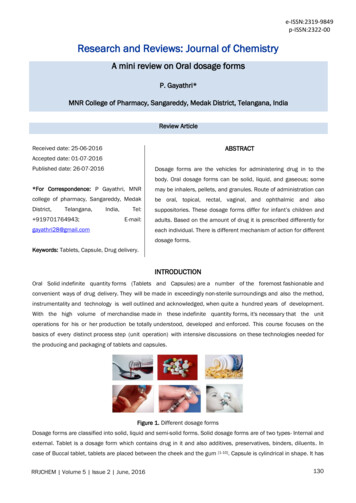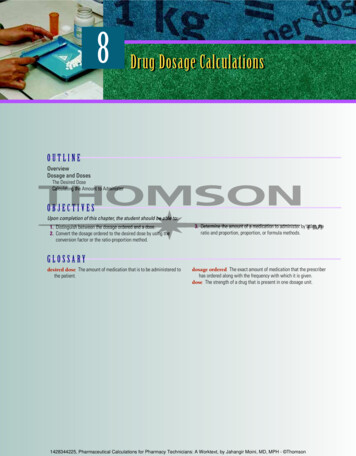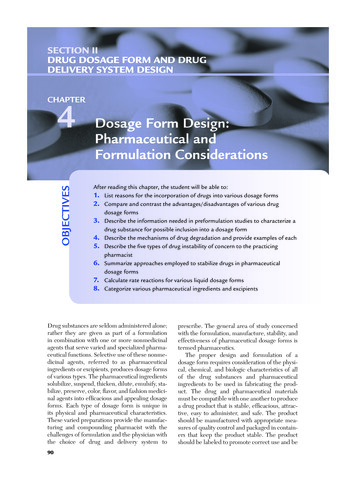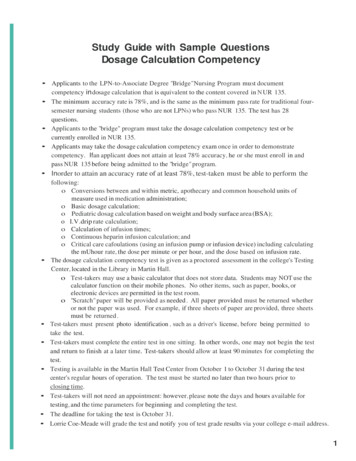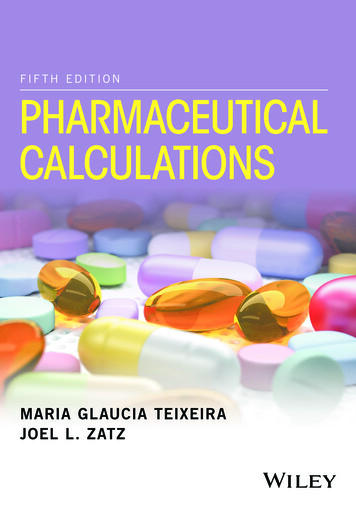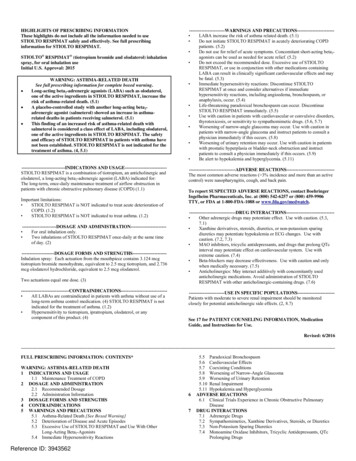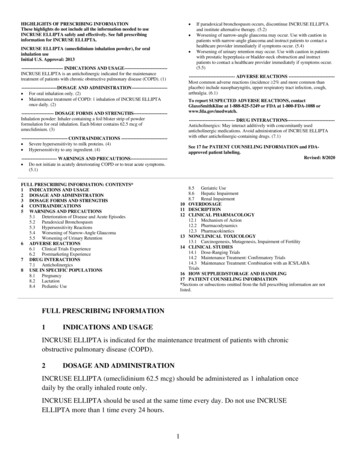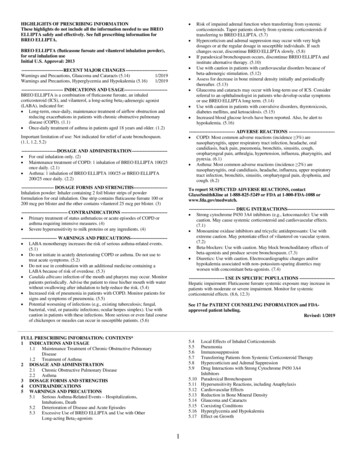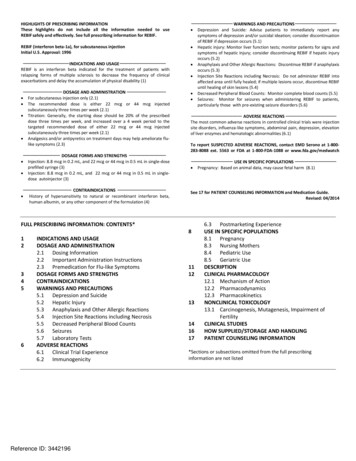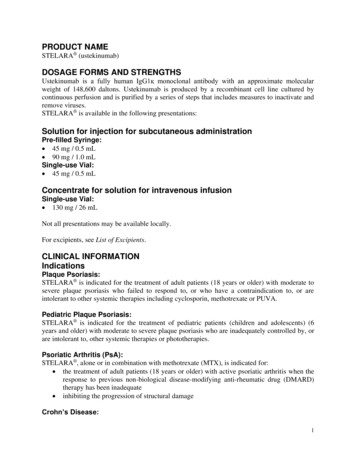
Transcription
PRODUCT NAMESTELARA (ustekinumab)DOSAGE FORMS AND STRENGTHSUstekinumab is a fully human IgG1қ monoclonal antibody with an approximate molecularweight of 148,600 daltons. Ustekinumab is produced by a recombinant cell line cultured bycontinuous perfusion and is purified by a series of steps that includes measures to inactivate andremove viruses.STELARA is available in the following presentations:Solution for injection for subcutaneous administrationPre-filled Syringe: 45 mg / 0.5 mL 90 mg / 1.0 mLSingle-use Vial: 45 mg / 0.5 mLConcentrate for solution for intravenous infusionSingle-use Vial: 130 mg / 26 mLNot all presentations may be available locally.For excipients, see List of Excipients.CLINICAL INFORMATIONIndicationsPlaque Psoriasis:STELARA is indicated for the treatment of adult patients (18 years or older) with moderate tosevere plaque psoriasis who failed to respond to, or who have a contraindication to, or areintolerant to other systemic therapies including cyclosporin, methotrexate or PUVA.Pediatric Plaque Psoriasis:STELARA is indicated for the treatment of pediatric patients (children and adolescents) (6years and older) with moderate to severe plaque psoriasis who are inadequately controlled by, orare intolerant to, other systemic therapies or phototherapies.Psoriatic Arthritis (PsA):STELARA , alone or in combination with methotrexate (MTX), is indicated for: the treatment of adult patients (18 years or older) with active psoriatic arthritis when theresponse to previous non-biological disease-modifying anti-rheumatic drug (DMARD)therapy has been inadequate inhibiting the progression of structural damageCrohn’s Disease:1
STELARA is indicated for the treatment of adults with moderately to severe active Crohn’sdisease who have: failed or were intolerant to treatment with immunomodulators or corticosteroids, butnever failed treatment with a tumor necrosis factor (TNF) blocker or failed or were intolerant to treatment with one or more TNF blockersUlcerative Colitis:STELARA is indicated for the treatment of adult patients with moderately to severely activeulcerative colitis who have had an inadequate response with, lost response to, or were intolerantto either conventional therapy or a biologic or have medical contraindications to such therapies.Dosage and AdministrationDosage – AdultsPlaque PsoriasisFor the treatment of plaque psoriasis, STELARA is administered by subcutaneous injection.STELARA is intended for use under the guidance and supervision of a physician experienced inthe diagnosis and treatment of psoriasis.1. For patients weighing 100 kg, the recommended dose is 45 mg initially and 4 weeks later,followed by dosing every 12 weeks.2. For patients weighing 100 kg, alternatively a dose of 90 mg initially and 4 weeks later,followed by dosing every 12 weeks may be used.In patients weighing 100 kg, 45mg was also shown to be efficacious. However, 90mg resultedin greater efficacy in these patients.Re-treatmentRe-treatment with a dosing regimen of Weeks 0 and 4, followed by 12 weeks dosing afterinterruption of therapy has been shown to be safe and effective.Psoriatic ArthritisFor the treatment of psoriatic arthritis, STELARA is administered by subcutaneous injection.The recommended dose of STELARA is 45 mg administered at Weeks 0 and 4, then every 12weeks thereafter. Alternatively, 90 mg may be used in patients with a body weight greater than100 kg.Consideration should be given to discontinuing treatment in patients who have shown noresponse up to 28 weeks of treatment.Crohn’s Disease and Ulcerative ColitisIn patients with Crohn’s disease and ulcerative colitis, the recommended treatment regimen is asingle intravenous (IV) tiered dose of STELARA based on body weight (Table 1), followed by90 mg subcutaneous dosing 8 weeks later, then every 8 weeks thereafter (see Instructions forUse, Handling and Disposal).2
Table 1: Initial IV dosing of STELARA aBody Weight of Patient at the time ofdosing 55 kg 55 kg to 85 kg 85 kgaRecommended dose (approximately 6mg/kg)Dose260 mg390 mg520 mgNumber of130 mg STELARA Vials234For some patients, a single IV dose based on body weight (Table 1) followed by 90 mgsubcutaneous dosing 8 weeks later, then every 12 weeks thereafter may be acceptable accordingto clinical judgment. Patients who inadequately respond to 90 mg subcutaneous dosing every 12weeks may benefit from an increase in dosing frequency to every 8 weeks (see Clinical Studies).Immunomodulators and/or corticosteroids may be continued during treatment with STELARA .In patients who have responded to treatment with STELARA corticosteroids may be reduced ordiscontinued in accordance with standard of care.If therapy in Crohn’s disease or Ulcerative Colitis is interrupted, resumption of treatment withsubcutaneous dosing every 8 weeks is safe and effective.Dosage – Pediatric Population (6 years and older)Plaque PsoriasisFor the treatment of plaque psoriasis, STELARA should be administered by subcutaneousinjection. The recommended dose of STELARA based on body weight is shown below(Table 2). STELARA should be administered at week 0 and 4, then every 12 weeks thereafter.Table 2a:Recommended dose of STELARA for pediatric psoriasisWeightRecommended DoseDosage Form 60 kg0.75 mg/kg*vial 60 to 100 kg45 mgPre-filled syringe, vial 100 kg90 mgPre-filled syringe, vial*To calculate the volume of injection (mL) for patients 60 kg, use the following formula:Body weight (kg) x 0.0083 (mL/kg). The calculated volume should be rounded to the nearest 0.01 mLand administered using a 1 mL graduated syringe. A 45 mg vial is available for pediatric patients whoneed to receive less than the full 45 mg dose.Table 2b:Injection volumes of STELARA for paediatric psoriasis patients 60 kgBody weight at time of dosingDose (mg)Volume of injection 0.120.130.140.150.160.170.173
430.440.450.460.460.470.480.49General Consideration for AdministrationSubcutaneous administrationSTELARA is intended for use under the guidance and supervision of a physician. In pediatricpatients, it is recommended that STELARA be administered by a health-care provider.Patients or their caregivers may inject STELARA if a physician determines that it is appropriate4
and with medical follow-up as necessary, after proper training in subcutaneous injectiontechnique and disposal (see Instructions for Use, Handling and Disposal).Comprehensive instructions for the subcutaneous administration of STELARA are given in the“Patient Information Leaflet”. Patients should be instructed to inject the prescribed amount ofSTELARA according to the directions provided in the patient information leaflet. The needlecover on the pre-filled syringe contains dry natural rubber (a derivative of latex), which maycause allergic reactions in individuals sensitive to latex.Prior to subcutaneous administration, visually inspect the solution in the STELARA vial forparticulate matter and discoloration. The product is colorless to light yellow and may contain afew small translucent or white particles of protein. This appearance is not unusual forproteinaceous solutions. The product should not be used if solution is discolored or cloudy, or ifother particulate matter is present. STELARA does not contain preservatives; therefore anyunused product remaining in the vial and syringe should not be used.Intravenous infusion (Crohn’s Disease and Ulcerative Colitis)STELARA 130 mg vial is for IV infusion only. Intravenous infusion of STELARA should beadministered by qualified health-care professionals (for preparation, see Instructions for Use,Handling and Disposal).Special populationsPediatricsStudies of STELARA in pediatric patients below 6 years of age have not been conducted. Nostudies have been conducted in pediatric patients with psoriatic arthritis, Crohn’s disease orulcerative colitis.ElderlyOf the 6709 patients exposed to STELARA , a total of 353 were 65 years or older (183 patientswith psoriasis, 69 patients with psoriatic arthritis, 58 with Crohn’s disease, and 43 patients withulcerative colitis). No major age-related differences in clearance or volume of distribution wereobserved in clinical studies. Although no overall differences in safety or efficacy were observedbetween older and younger patients in clinical studies in approved indications, the number ofpatients aged 65 and over is not sufficient to determine whether they respond differently fromyounger patients.Renal impairmentSpecific studies have not been conducted in patients with renal insufficiency.Hepatic impairmentSpecific studies have not been conducted in patients with hepatic insufficiency.ContraindicationsSevere hypersensitivity to ustekinumab or to any of the excipients (see Warnings andPrecautions).5
Warnings and PrecautionsInfectionsSTELARA is a selective immunosuppressant and may have the potential to increase the risk ofinfections and reactivate latent infections.In clinical studies, serious bacterial, fungal, and viral infections have been observed in patientsreceiving STELARA .STELARA should not be given to patients with a clinically important, active infection. Cautionshould be exercised when considering the use of STELARA in patients with a chronic infectionor a history of recurrent infection.Prior to initiating treatment with STELARA , patients should be evaluated for both active andinactive (latent) tuberculosis infection. The evaluation should include a detailed medical historywith possible previous exposure to patients with active tuberculosis and previous and/or currentimmunosuppressive therapy. Appropriate screening tests (tuberculin test with or without a chestradiograph) should be performed in accordance with local recommendations. STELARA shouldnot be given to patients with active tuberculosis. Treatment of latent tuberculosis should beinitiated prior to therapy with STELARA . The possibility of undetected latent tuberculosisshould be considered especially in patients who have immigrated from or travelled to countrieswith a high prevalence of tuberculosis or who had close contact with a person with activetuberculosis. Anti-tuberculosis therapy should also be considered prior to initiation ofSTELARA in patients with a past history of latent or active tuberculosis in whom an adequatecourse of treatment cannot be confirmed. Patients receiving STELARA should be monitoredclosely for signs and symptoms of active tuberculosis during and after treatment.Patients should be instructed to seek medical advice if signs or symptoms suggestive of aninfection occur. If a patient develops a serious infection they should be closely monitored andSTELARA should not be administered until the infection resolves (see Adverse Reactions).MalignanciesSTELARA is a selective immunosuppressant. Immunosuppressive agents have the potential toincrease the risk of malignancy. Some patients who received STELARA in clinical studiesdeveloped cutaneous and noncutaneous malignancies (see Adverse Reactions).STELARA has not been studied in patients with a history of malignancy or in patients whodevelop malignancy while receiving STELARA . Caution should be exercised when consideringthe use of STELARA in patients with a history of malignancy or when considering continuingtreatment in patients who develop a malignancy.All patients, in particular those greater than 60 years of age, patients with a medical history ofprolonged immunosuppressant therapy or those with a history of PUVA treatment, should bemonitored for the appearance of non-melanoma skin cancer (see Adverse Reactions).Hypersensitivity reactions6
In post-marketing experience, serious hypersensitivity reactions, including anaphylaxis andangioedema have been reported. If an anaphylactic or other serious hypersensitivity reactionoccurs, institute appropriate therapy and the administration of STELARA should bediscontinued immediately (see Adverse Reactions).Serious Skin ReactionsIn patients with psoriasis, exfoliative dermatitis has been reported following ustekinumabtreatment. Patients with plaque psoriasis may develop erythrodermic psoriasis, with symptomsthat may be clinically indistinguishable from exfoliative dermatitis, as part of the natural courseof their disease. As part of the monitoring of the patient’s psoriasis, physicians should be alert forsymptoms of erythrodermic psoriasis or exfoliative dermatitis. If these symptoms occur,appropriate therapy should be instituted. STELARA should be discontinued if a drug reaction issuspected.ImmunizationsIt is recommended that live viral or live bacterial vaccines not be given concurrently withSTELARA .No data are available on the secondary transmission of infection by live vaccines in patientsreceiving STELARA . Caution is advised when administering some live vaccines to householdcontacts of patients receiving STELARA because of the potential risk for shedding from thehousehold contact and transmission to the patient. Specific studies have not been conducted inpatients who had recently received live viral or live bacterial vaccines. Before live viral or livebacterial vaccination, treament with STELARA should be withheld for at least 15 weeks afterthe last dose and can be resumed at least 2 weeks after vaccination.Patients receiving STELARA may receive concurrent inactivated or non-live vaccinations.Long-term treatment with STELARA does not suppress the humoral immune response topneumococcal polysaccharide or tetanus vaccines (see Pharmacodynamic Properties).ImmunosuppressionIn psoriasis studies, the safety and efficacy of STELARA in combination withimmunosuppressive agents or phototherapy have not been evaluated. In psoriatic arthritis studies,concomitant MTX use did not appear to influence the safety or efficacy of STELARA . InCrohn’s disease and ulcerative colitis studies, concomitant use of immunomodulators (6mercaptopurine (6-MP), azathioprine (AZA), MTX) or corticosteroids did not appear toinfluence the safety or efficacy of STELARA . Caution should be exercised when consideringconcomitant use of immunosuppressive agents and STELARA or when transitioning from otherbiologic agents.ImmunotherapySTELARA has not been evaluated in patients who have undergone allergy immunotherapy.STELARA may affect allergy immunotherapy. Caution should be exercised in patientsreceiving or who have received allergy immunotherapy particularly for anaphylaxis.7
GeneralThe needle cover on the pre-filled syringe contains dry natural rubber (a derivative of latex),which may cause allergic reactions in individuals sensitive to latex.InteractionsDrug interaction studies have not been conducted in humans with STELARA (seePharmacokinetic Properties).Live vaccines should not be given concurrently with STELARA (see Warnings andPrecautions).The safety and efficacy of STELARA in combination with other immunosuppressants,including biologics, or phototherapy have not been evaluated.The effects of IL-12 or IL-23 on the regulation of CYP450 enzymes were evaluated in an in vitrostudy using human hepatocytes, which showed that IL-12 and/or IL-23 at levels of 10 ng/mL did notalter human CYP450 enzyme activities (CYP1A2, 2B6, 2C9, 2C19, 2D6, or 3A4). These results donot suggest the need for dose adjustments in patients who are receiving concomitant CYP450substrates (see Pharmacokinetic Properties).In psoriasis studies, the safety and efficacy of STELARA in combination withimmunosuppressants, including biologics, or phototherapy have not been evaluated.In psoriatic arthritis studies, concomitant MTX use did not appear to influence the safety orefficacy of STELARA .Pregnancy, Breast-feeding and FertilityPregnancyThere is no evidence from animal studies of teratogenicity, birth defects or developmental delaysat exposures up to approximately 150-fold higher compared to Cmax following 4 weekly 90 mgsubcutaneous injections or up to 21-fold higher compared to serum concentrations 1h following6 mg/kg IV administration (see Non-Clinical Information). However, animal reproductive anddevelopmental studies are not always predictive of human response.It is not known whether STELARA can cause fetal harm when administered to a pregnantwoman or can affect reproduction capacity. STELARA should be given to a pregnant womanonly if the benefit clearly outweighs the risk.Breast-feedingSTELARA is excreted in the milk of lactating monkeys administered STELARA . It is notknown if STELARA is absorbed systemically after ingestion. Because many drugs andimmunoglobulins are excreted in human milk, and because of the potential for adverse reactionsin nursing infants from STELARA , a decision should be made whether to discontinue nursingor to discontinue the drug.8
FertilityThe effect of STELARA on human fertility has not been evaluated. No adverse effects onfemale fertility parameters were identified in a female fertility toxicity study conducted in mice(see Non-Clinical Information).Effects on Ability to Drive and Use MachinesNo studies on the effects on the ability to drive and use machines have been performed.Adverse ReactionsThroughout this section, adverse reactions are presented. Adverse reactions are adverse eventsthat were considered to be reasonably associated with the use of ustekinumab based on thecomprehensive assessment of the available adverse event information. A causal relationship withustekinumab usually cannot be reliably established in individual cases.Clinical Studies Experience in Adult Patients with Psoriasis, Psoriatic Arthritis,Crohn’s Disease, and Ulcerative ColitisThe safety data described below reflect exposure to STELARA in 14 Phase 2 and Phase 3studies in 6709 patients (4135 with psoriasis and/or psoriatic arthritis, 1749 for Crohn’s disease,and 825 with ulcerative colitis in UC-1 and UC-2 clinical trials), with duration of exposure toSTELARA presented in Table 3.Table 3: Long-term exposure to STELARA in Phase 2 and Phase 3 clinical studiesExposureNumber of patients6 months4577a1 year3253a 4 years1482b 5 years838baTotal number of patients in the psoriasis, psoriatic arthritis, Crohn’s disease, and ulcerative colitis studiesbNumber of patients with psoriasisThe most common adverse reactions ( 5%) in controlled periods of the clinical studies withSTELARA among all indications were nasopharyngitis and headache. Most were considered tobe mild and did not necessitate drug discontinuation. The overall safety profile of STELARA was similar for patients among all indications.Table 4 provides a summary of Adverse Reactions from the clinical studies. The frequency ofthese adverse reactions was based on those that occurred during the initial controlled periods ofthe clinical studies. The adverse reactions are ranked by frequency, using the followingconvention:Very commonCommon (frequent)Uncommon (infrequent)Rare( 1/10)( 1/100, 1/10)( 1/1000, 1/100)( 1/10000, 1/1000)9
Table 4: Summary of Adverse Reactions in Psoriasis and Psoriatic Arthritis Clinical StudiesInfections and infestationsCommon: Upper respiratory tract infection, nasopharyngitis, sinusitisUncommon: Cellulitis, dental infections, herpes zoster, viral upperrespiratory tract infection, vulvovaginal mycotic infectionPsychiatric disordersUncommon: DepressionNervous system disordersCommon: Dizziness, headacheUncommon: Facial palsyRespiratory, thoracic andCommon: Oropharyngeal painmediastinal disordersUncommon: Nasal congestionGastrointestinal disordersCommon: Diarrhea, nausea, vomitingSkin and subcutaneous tissueCommon: PruritusdisordersUncommon: Skin exfoliation, acneRare: Exfoliative dermatitis, erythrodermic psoriasisMusculoskeletal, connectiveCommon: Back pain, myalgia, arthralgiatissue and bone disordersGeneral disorders andCommon: Fatigue, injection site erythema, injection site painadministration site conditionsUncommon: injection site reactions (including hemorrhage, hematoma,induration, swelling and pruritus), astheniaInfectionsIn the placebo-controlled studies of patients with psoriasis, psoriatic arthritis, Crohn’s disease,and ulcerative colitis, the rates of infection or serious infection were similar betweenSTELARA -treated patients and those treated with placebo. In the placebo-controlled period ofthe clinical studies of patients with psoriasis, patients with psoriatic arthritis, patients withCrohn’s disease, and patients with ulcerative colitis, the rate of infection was 1.36 and 1.34 perpatient-year of follow-up in STELARA and placebo-treated patients, respectively. Seriousinfections occurred at a rate of 0.03 per patient-year of follow-up in STELARA -treated patients(30 serious infections in 930 patient-years of follow-up) and 0.03 per patient-year of follow-up inplacebo-treated patients (15 serious infections in 434 patient-years of follow-up).In the controlled and non-controlled periods of psoriasis, psoriatic arthritis, Crohn’s disease, andulcerative colitis clinical studies representing 11581 patient-years of exposure in 6709 patients,the median follow-up was 1.0 years; 1.1 years for psoriatic disease studies, 0.6 year for Crohn’sdisease studies, and 1.0 years for ulcerative colitis studies. The rate of infection was 0.91 perpatient-year of follow-up in STELARA -treated patients. The rate of serious infections was 0.02per patient-year of follow-up in STELARA -treated patients (199 serious infections in 11581patient-years of follow-up) and included pneumonia, anal abscess, cellulitis, diverticulitis,gastroenteritis and viral infections.In clinical studies, patients with latent tuberculosis who were concurrently treated with isoniaziddid not develop tuberculosis.MalignancyIn the placebo-controlled period of the psoriasis, psoriatic arthritis, Crohn’s disease, andulcerative colitis clinical studies, the incidence of malignancies excluding non-melanoma skincancer was 0.11 per 100 patient-years of follow-up for STELARA -treated patients (1 patient in929 patient-years of follow-up) and 0.23 per 100 patient-years of follow-up for placebo-treatedpatients (1 patient in 434 patient-years of follow-up). The incidence of non-melanoma skincancer was 0.43 per 100 patient-years of follow-up for STELARA -treated patients (4 patients in10
929 patient-years of follow-up) compared with 0.46 per 100 patient-years of follow-up forplacebo-treated patients (2 patients in 433 patient-years of follow-up).In the controlled and non-controlled periods of the psoriasis, psoriatic arthritis, Crohn’s diseaseand ulcerative colitis clinical studies representing 11561 patient-years of exposure in 6709patients, the median follow-up was 1.0 years; 1.1 years for psoriatic disease studies, 0.6 year forCrohn’s disease studies, and 1.0 years for ulcerative colitis studies. Malignancies, excluding nonmelanoma skin cancers, were reported in 62 patients in 11561 patient-years of follow-up (withan incidence of 0.54 per 100 patient-years of follow-up for STELARA -treated patients). Theincidence of non-melanoma skin cancer was 0.49 per 100 patient-years of follow-up forSTELARA -treated patients. The incidence of malignancies reported in STELARA -treatedpatients was comparable to the incidence expected in the general population (standardizedincidence ratio 0.93 [95% confidence interval: 0.71, 1.20]), adjusted for age, gender and race).The most frequently observed malignancies, other than non-melanoma skin cancer, wereprostate, colorectal, melanoma, and breast. The ratio of patients with basal versus squamous cellskin cancers (3:1) is comparable with the ratio expected in the general population (see Warningsand Precautions).Hypersensitivity and Infusion ReactionsSubcutaneous administrationDuring the controlled periods of the psoriasis and psoriatic arthritis clinical studies ofSTELARA , rash and urticaria have each been observed in 1% of patients.IV administrationIn Crohn’s disease and ulcerative colitis intravenous induction studies, no events of anaphylaxisor other serious infusion reactions were reported. In Crohn’s disease studies, 2.4% of 466placebo treated patients and 2.6% of 470 patients treated with the recommended dose ofSTELARA reported adverse events occurring during or within an hour of the infusion. Inulcerative colitis studies, 1.9% of 319 placebo patients and 0.9% of 320 patients treated with therecommended dose of STELARA reported adverse events occurring during or within an hour ofthe infusion.ImmunogenicityIn psoriasis and psoriatic arthritis clinical studies, up to 12.4% of patients treated withSTELARA , developed antibodies to ustekinumab. Patients positive for antibodies toustekinumab tended to have lower efficacy, however, antibody positivity did not preclude aclinical response. The majority of patients who were positive for antibodies to ustekinumab hadneutralizing antibodies. In Crohn’s disease and ulcerative colitis clinical studies, 2.9 and 4.6% ofpatients, respectively, developed antibodies to ustekinumab when treated with ustekinumab forapproximately one year. No apparent association between the development of antibodies toustekinumab and the development of injection site reactions was observed.OverdoseSingle doses up to 6 mg/kg intravenously have been administered in clinical studies withoutdose-limiting toxicity. In case of overdosage, it is recommended that the patient be monitored for11
any signs or symptoms of adverse reactions or effects and appropriate symptomatic treatment beinstituted immediately.Clinical Studies Experience in Pediatric Patients with PsoriasisThe safety of STELARA has been studied in two phase 3 studies of pediatric patients withmoderate to severe plaque psoriasis. The first study was in 110 patients from 12 to 17 years ofage treated for up to 60 weeks (CADMUS) and the second study was in 44 patients from 6 to 11years of age treated for up to 56 weeks (CADMUS Jr.). In general, the adverse events reported inthese two studies were similar to those seen in previous studies in adults with plaque psoriasis(see Clinical Studies Experience in Adult Patients with Psoriasis and/or Psoriatic Arthritissection above).Post Marketing ExperienceThe adverse reactions in Table 5 are ranked by frequency* using the following convention:Very common:Common:Uncommon:Rare:Very rare:Table 5: Post-Marketing ReportsImmune system disordersInfections and infestationsRespiratory,thoracicmediastinal disordersSkin and subcutaneousdisordersandtissue 1/10 1/100 and 1/10 1/1000 and 1/100 1/10000 and 1/1000 1/10000, including isolated reportsUncommon: Hypersensitivity reactions (including rash, urticaria)Rare: Serious hypersensitivity reactions (including anaphylaxis andangioedema)Uncommon: Lower respiratory tract infectionRare: Allergic alveolitis, eosinophilic pneumoniaUncommon: Pustular psoriasisRare: Erythrodermic psoriasis, hypersensitivity vasculitis*Post-marketing adverse reaction frequency is derived from the placebo-controlled portion of the 11 clinical trials ifthe adverse reaction was observed in those trials. Otherwise, it is estimated to be lower than a certain frequencygiven the exposure in the 11 clinical trials where the adverse reaction was not observed.PHARMACOLOGICAL PROPERTIESPharmacodynamic PropertiesPharmacotherapeutic group: Immunosuppressants, interleukin inhibitors, ATC code: L04AC05Mechanism of actionSTELARA is a fully human IgG1қ monoclonal antibody that binds with specificity to theshared p40 protein subunit of human cytokines interleukin (IL)-12 and IL-23. STELARA inhibits the bioactivity of human IL-12 and IL-23 by preventing p40 from binding to the IL12Rβ1 receptor protein expressed on the surface of immune cells. STELARA cannot bind toIL-12 or IL-23 that is already bound to IL-12R 1 cell surface receptors. Thus, STELARA is12
not likely to contribute to complement or antibody mediated cytotoxicity of cells expressing IL12 and/or IL-23 receptors.IL-12 and IL-23 are heterodimeric cytokines secreted by activated antigen presenting cells, suchas macrophages and dendritic cells. IL-12 stimulates natural killer (NK) cells and drives thedifferentiation of CD4 T cells toward the T helper 1 (Th1) phenotype and stimulates interferongamma (IFNγ) production. IL-23 induces the T helper 17 (Th17) pathway and promotessecretion of IL-17A, IL-21, and IL-22. Levels of IL-12 and IL- 23 are elevated in the skin andblood of patients with psoriasis, and serum IL12/23p40 distinguishes patients with psoriaticarthritis from healthy individuals, implicating IL-12 and IL-23 in the pathophysiology ofpsoriatic inflammatory diseases. Genetic polymorphisms in IL23A, IL23R, and IL-12B genesconfer susceptibility to these disorders. Additionally, IL-12 and IL-23 are highly expressed inlesional psoriatic skin, and IL-12-mediated induction of IFNγ correlates with psoriasis diseaseactivity. IL-23 responsive T-cells have been found in the entheses in a mouse model ofinflammatory arthritis, where IL-23 drives entheseal inflammation. In addition, there is preclinical evidence implicating IL-23 and downstream pathways in bone erosion and destructionthrough up-regulation of receptor activator of nuclear factor-κB ligand (RANKL), whichactivates osteoclasts.In patients with Crohn’s disease, IL-12 and IL-23 are elevated in the intestines and lymph nodes.This is accompanied by increases in serum IFN and IL-17A levels, suggesting that IL-12 andIL-23 promote Th1 and Th17 activation in Crohn’s disease. Both IL-12 and IL-23 can alsostimulate TNF production by T cells, resulting in chronic intestinal inflammation and epithelialcell injur
For the treatment of plaque psoriasis, STELARA is administered by subcutaneous injection. STELARA is intended for use under the guidance and supervision of a physician experienced in the diagnosis and treatment of psoriasis. 1. For patients weighing 100 kg, the recommended dose is 45 mg initially and 4 weeks later,
